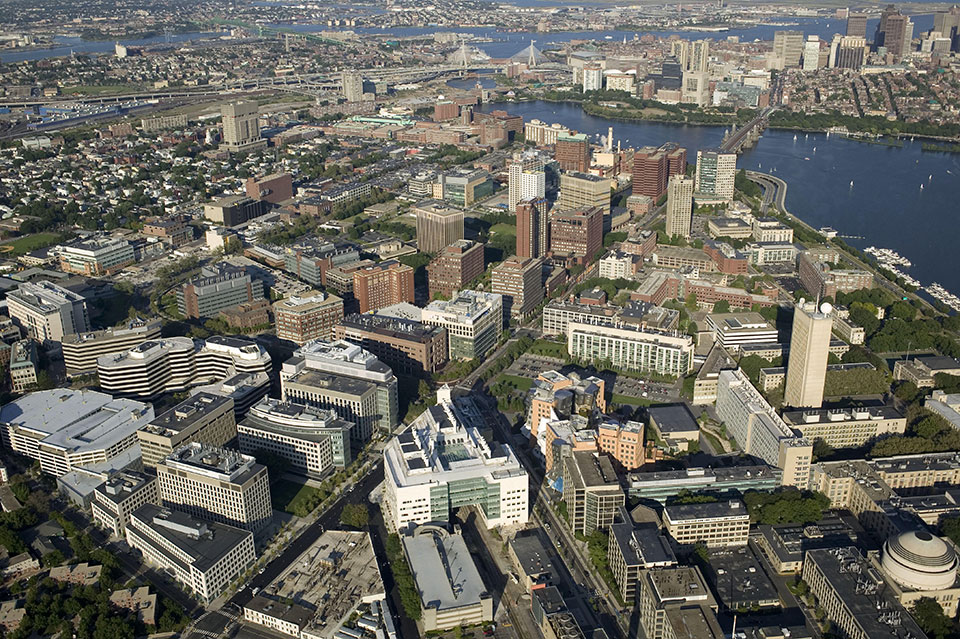The Future of Innovation Districts

The way in which organizations innovate, and places where they are based to do this, have changed profoundly over the last decade due to two overall trends – convergence and disruption. Companies have moved away from closed innovation models to more open approaches in which organizations and places work in collaborative ecosystems and networks, forming “uncommon partnerships” between previously unrelated industries.
Enabling these partnerships is crucial as organizations look to embrace new growth paradigms. Providing the right physical location for this innovation to occur is vital. That has led to the development of the Innovation District concept. An Innovation District is a dense geographical area or “neighborhood” of supportive economic activity focused on innovation, which is near to one or more institutes of higher education, often in an urban environment that is ripe for regeneration. Unlike traditional science or business parks, rather than simply functioning as workplaces, Innovation Districts create places where people can live, work and play 24/7.
In the new, post-COVID-19 world of work, Innovation Districts are well-positioned to thrive. Not only do they enable serendipity and foster innovation through the intensive co-location of different businesses and organizations, but they also provide flexible, mixed-use office property with underpinning housing and entertainment offers. This makes them resilient and well equipped to grow despite the increase in virtual working.
Creating a successful and productive Innovation District that pulls in organizations and makes them want to stay is challenging, especially in terms of attracting tenants, creating a vibrant destination, and creating “diseconomies” of scale. As a District becomes larger, it also becomes more expensive for tenants and – as a result – less diverse, as smaller or less wealthy businesses are driven out of the area. Another challenge involves multidisciplinary stakeholder alignment: success requires buy-in from myriad property developers, local government authorities, universities, start-up founders, and the research and development departments of large, often international businesses, all of which have different priorities and expectations around risk, reward and return on investment.
With these challenges and issues in mind, Arthur D. Little and Steer Economic Development (Steer-ED) have benchmarked and engaged with some of the world’s most successful Innovation Districts over the last few years to identify the practical and tangible success factors to establish, grow and sustain a productive District for both developers and tenants.
The essential fundamentals of an Innovation District
Successful Innovation Districts possess the same common characteristics that provide the building blocks on which they and their tenants can develop and thrive: These include access to talent and research outputs from one or more leading universities; good transport connectivity and an unimpeded flow of people around the District itself; flexible accommodation to live, work and play, normally facilitated by a central location; wide-ranging amenities operating 24/7; and a relatively high population density that includes access to the professional services that “innovators” need to scale, including legal, finance (traditional and equity), accounting, and marketing.
However, there is a huge difference between what makes an Innovation District functional and what makes one successful in the long term. Underpinning these fundamental characteristics are eight key success factors (KSFs) that ensure that they are truly world class and differentiated in terms of attracting high-caliber talent, building a thriving community of businesses and, ultimately, becoming a success in terms of financial returns, job creation and social cohesion. (See Figure 2.)
Direction setting
KSF 1: Creating a long-term shared vision for value and wealth creation within and around the District
The greatest challenge in founding an Innovation District is obtaining alignment between multiple different stakeholders on what the District is trying to achieve. This is challenging because the value and wealth created are generally realized over a longer term compared to those of a conventional property development of retail, housing or offices, from which a quicker return can be made through property sales and rentals. Such benefits include job creation and knowledge generation, and wider socio-economic impacts such as health and well-being, engagement with local communities, environmental sustainability, and skills and learning. It is key here to obtain buy-in from all types of stakeholders – research-intensive companies, local government, universities and property developers – on what a 10–20-year Innovation District vision should entail.
KSF 2: Creating a distinctive and differentiated unique selling point (USP) for the District
To be successful, an Innovation District should initially be focused on a specific science and technology domain, providing a point of differentiation to attract tenants and then sustain occupancy. At the same time, this focus needs to be recognized and understood in the market.
Ecosystem activation
KSF 3: Build a high-quality, specific and relevant talent pipeline through effective engagement with academia
The availability of talent is one of the biggest draws for tenants to an Innovation District – but it must be relevant and world class to encourage businesses to establish themselves in close proximity. The talent pipeline must also be specific and related to the District’s USP.
The main source of this talent pipeline is the universities or other higher education institutions embedded in, or in close proximity to, the District, and Innovation Districts can also act as a recruitment pipeline for new graduates, which helps to attract and inspire increasing numbers of students, along with their university research focus domains. They, in turn, bring new business ideas and, ultimately, money.
KSF 4: Curating occupancy of the District and representing the whole supply chain
Selecting the right types of companies to be part of the cluster is important to determine the District’s direction, and also an important part of its value proposition. In addition, the mix of sizes of occupants within the District is important to maintain attractiveness and provide the optimum conditions for innovation to occur. Corporations, for example, like to be around start-ups due to their energy, access to cutting-edge technology, propensity for quicker innovations, and availability of talent.
KSF 5: Build an effective technology transfer operation focused on spinning out, incubation and acceleration to build deal flow and support new business creation
Proximity to “big brains” at a world-class university is critical, but just as critical is extracting knowledge from them. To support the flow of knowledge and talent from the universities associated with an Innovation District, a successful technology transfer operation is needed, supported by an effective industrial liaison function at universities, as well as access to wider sources of seed funding and investment capital. This is to avoid the possibility of core university functions being “distracted” by the District, which could impact their research and teaching excellence. Rather than seeking IP royalties from one-off patent license deals, the goal is to deliver long-term value creation through company establishment and growth.
KSF 6: Combine programmatic themes for interaction with “organized serendipity” and fun
The social engineering aspect of a successful Innovation District is also of pivotal importance, in order to create opportunities and environments for like-minded individuals to “collide” and form new and differentiated ideas. Good practice is to create a robust programming schedule, such as a “soft landing” program for new arrivals, trade missions to support international expansion of tenants, and presentations from keynote speakers that District tenants want to hear from. These initiatives are complemented by activities that allow collaborations to self-form and progress.
Physical offers
KSF 7: Create a public realm that forms a central destination and neighborhood in its own right
Many successful Districts have one or a few central common areas, with associated shared spaces, within a few minutes’ walk of one another, which act as collision spaces for occupants to interact with people they wouldn’t ordinarily meet, and which act as a “draw” to workers and the wider public to ensure a District which is alive 24/7 and a destination in its own right.
KSF 8: Create mixed-use, flexible and reconfigurable buildings – with flexible prices suitable for companies of all types and sizes
As a District grows larger and more successful, it also becomes more expensive, and rising rents can often drive out more diverse and creative businesses. Successful Districts offer highly flexible property offers, with different sizes and prices. It can be possible to offset the rents of smaller businesses by charging more to anchor tenants through intelligent cross-subsidies.
Conclusion
Where innovation takes place has changed radically over the last decade, with the rise of physical Innovation Districts across the world that bring together researchers, start-ups and corporates to work and live in open ecosystems. Our view is that even in a post-pandemic world, a long-term vision, USP, curated community of occupants, and site activation can create a high-value physical community and help to prevent an Innovation District from becoming just another urban business park.
Written by Phil Webster (Arthur D. Little), Simon Pringle (Steer Economic Development). With thanks to and support from: Elis Wilkins, Ben Thuriaux-Alemán and Dr. Raymond Khoury (Arthur D. Little)
Add CEOWORLD magazine to your Google News feed.
Follow CEOWORLD magazine headlines on: Google News, LinkedIn, Twitter, and Facebook.
This report/news/ranking/statistics has been prepared only for general guidance on matters of interest and does not constitute professional advice. You should not act upon the information contained in this publication without obtaining specific professional advice. No representation or warranty (express or implied) is given as to the accuracy or completeness of the information contained in this publication, and, to the extent permitted by law, CEOWORLD magazine does not accept or assume any liability, responsibility or duty of care for any consequences of you or anyone else acting, or refraining to act, in reliance on the information contained in this publication or for any decision based on it.
Copyright 2024 The CEOWORLD magazine. All rights reserved. This material (and any extract from it) must not be copied, redistributed or placed on any website, without CEOWORLD magazine' prior written consent. For media queries, please contact: info@ceoworld.biz
SUBSCRIBE NEWSLETTER











